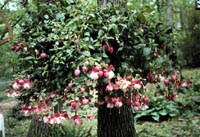Resource Library
Plant of the Week: Fuchsia
The University of Arkansas System Division of Agriculture does not promote, support or recommend plants featured in "Plant of the Week." Please consult your local Extension office for plants suitable for your region.
Plant of the Week
Fuchsia
Latin: Fuchsia coccinea

The garden fuchsia was an instant hit when it was introduced into European gardens, but it was slow to arrive because of the political intrigues of a bygone era.
Today we see this plant with beautiful drooping flowers, usually in vividly contrasting colors, as a hanging basket plant but it can also be used in the flower garden. When it was finally introduced into cultivation during the late 1700's it quickly rose to superstar status and became the most popular flower of the Victorian era - the high water mark of gardening.
Fuchsia naturally occurs in territory that Spain claimed as its own. That nation was trying to hold on to vast stretches of the New World with only limited resources. France had been shut out of the Caribbean, but in the late 17th Century, Louis XIV hit upon a scheme to establish a beachhead by coming to the aid of Spain against England in exchange for a piece of the island of Hispaniola. Today, that territory is Haiti.
Michel Begon, after whom the begonia is named, was sent as governor along with Father Charles Plumier, to minister to the religious needs of the inhabitants. Both were interested in natural history and described the new plants of the island, including the bush with pendant flowers that had red sepals and blue petals. Plumier published a description of the plants in 1703 and named the new plant after Leonhard Fuchs, a German botanist.
The first plant to reach Europe alive did so of the breakdown of an English sailing ship returning from China. The ship, under the command of a Captain Firth, had to pull into Chile for repairs before attempting the stormy Strait of Magellan passage. While making the repairs, Firth walked the shore and happened upon a beautiful exotic he thought his mother might like, so he dug it up and took it home to her perched on the window of his cabin. It flourished and a nurseryman soon saw its potential and quickly introduced it to the trade of the plant-hungry European market. This led to a stampede to find new kinds of fuchsias and over the next century almost 100 species were found, mostly in the territory that Spain was trying to keep closed.
Fuchsias are beautiful garden plants that require bright light to bloom, but resent our high humidity and summer temperatures. An area that gets good light, but not the hot afternoon sun, is best. They should never be allowed to wilt but should not stand in water either.
To see them in their perfection one must travel in the vicinity of the Canadian border, but they are so beautiful and there are so many kinds, most garden centers carry a wide array in the spring.
They do their best from April through June, with fewer flowers in July and August. More blooms can be had in the fall if plants receive a fertilization during the summer with a complete garden fertilizer.
By: Gerald Klingaman, retired
Extension Horticulturist - Ornamentals
Extension News - January 29, 1999
The University of Arkansas System Division of Agriculture does not maintain lists of retail outlets where these plants can be purchased. Please check your local nursery or other retail outlets to ask about the availability of these plants for your growing area.